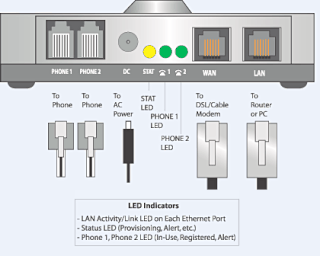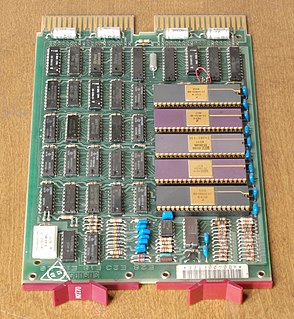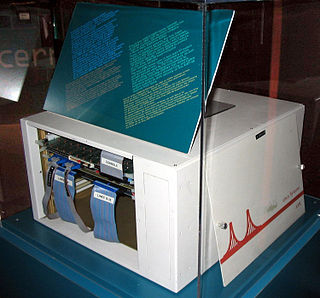In computing, a network interface is a system's interface between two pieces of equipment or protocol layers in a computer network.

In telecommunications, a network interface device is a device that serves as the demarcation point between the carrier's local loop and the customer's premises wiring. Outdoor telephone NIDs also provide the subscriber with access to the station wiring and serve as a convenient test point for verification of loop integrity and of the subscriber’s inside wiring.

A digital subscriber line access multiplexer is a network device, often located in telephone exchanges, that connects multiple customer digital subscriber line (DSL) interfaces to a high-speed digital communications channel using multiplexing techniques.

Linksys is an American company selling data networking hardware products mainly to home users and small businesses. Its products include wired and wireless routers, Ethernet switches, VoIP equipment, wireless Internet video cameras, audio visual products and network storage systems.
A softswitch is a central device in a telecommunications network which connects telephone calls from one phone line to another, across a telecommunication network or the public Internet, entirely by means of software running on a general-purpose computer system. Most landline calls are routed by purpose-built electronic hardware; however, soft switches using general purpose servers and VoIP technology are becoming more popular.

A telephone hybrid is the component at the ends of a subscriber line of the public switched telephone network (PSTN) that converts between two-wire and four-wire forms of bidirectional audio paths. When used in broadcast facilities to enable the airing of telephone callers, the broadcast-quality telephone hybrid is known as a broadcast telephone hybrid or telephone balance unit.

An analog telephone adapter (ATA) is a device for connecting traditional analog telephones, fax machines, and similar customer-premises devices to a digital telephone system or a voice over IP telephony network.

A business telephone system is a multiline telephone system typically used in business environments, encompassing systems ranging from the small key telephone system (KTS) to the large private branch exchange (PBX).

An intercom, talkback or doorphone is a stand-alone voice communications system for use within a building or small collection of buildings, functioning independently of the public telephone network. Intercoms are generally mounted permanently in buildings and vehicles. Intercoms can incorporate connections to public address loudspeaker systems, walkie talkies, telephones, and to other intercom systems. Some intercom systems incorporate control of devices such as signal lights and door latches.

A VoIP phone or IP phone uses voice over IP technologies for placing and transmitting telephone calls over an IP network, such as the Internet, instead of the traditional public switched telephone network (PSTN).

A digital subscriber line (DSL) modem is a device used to connect a computer or router to a telephone line which provides the digital subscriber line service for connectivity to the Internet, which is often called DSL broadband.

A DSL filter is an analog low-pass filter installed between analog devices and a plain old telephone service (POTS) line. The DSL filter prevents interference between such devices and a digital subscriber line (DSL) service connected to the same line. Without DSL filters, signals or echoes from analog devices at the top of their frequency range can reduce performance and create connection problems with DSL service, while those from the DSL service at the bottom of its range can cause line noise and other problems for analog devices.
Loop start is a telecommunications supervisory protocol between a central office or private branch exchange (PBX) and a subscriber telephone or other terminal for the purpose of starting and terminating a telephone call. It is the simplest of the telephone signaling systems, and uses the presence or absence of loop current to indicate the off-hook and on-hook loop states, respectively. It is used primarily for subscriber line signaling. An extension of the protocol that adds disconnect supervision is often called kewlstart.
There are many interface standards between analog telephone central office equipment and customer-premises equipment. Single voice paths generally include analog audio connections, either a two-wire circuit or four-wire circuit plus signaling paths to indicate call progress and status information, such as ringing, answer supervision, etc. Some of the known interface types are
Foreign exchange service (FX) is a telecommunications network service in which a telephone in a given exchange area is connected, via a private line, to a telephone exchange or central office in another foreign exchange, rather than the local exchange area where the device is located.

The media gateway control protocol architecture is a methodology of providing telecommunication services using decomposed multimedia gateways for transmitting telephone calls between an Internet Protocol network and traditional analog facilities of the public switched telephone network (PSTN). The architecture was originally defined in RFC 2805 and has been used in several prominent voice over IP (VoIP) protocol implementations, such as the Media Gateway Control Protocol (MGCP) and Megaco (H.248), both successors to the obsolete Simple Gateway Control Protocol (SGCP).
A VoIP gateway is a gateway device that uses Internet Protocols to transmit and receive voice communications (VoIP). The general term is ambiguous and can mean many different things. There are many such devices. They are quickly becoming the most common type of voice phone service in many areas.
Obihai Technology manufactures analog telephone adapters which support SIP, XMPP and Google Voice compatible Internet telephony.












